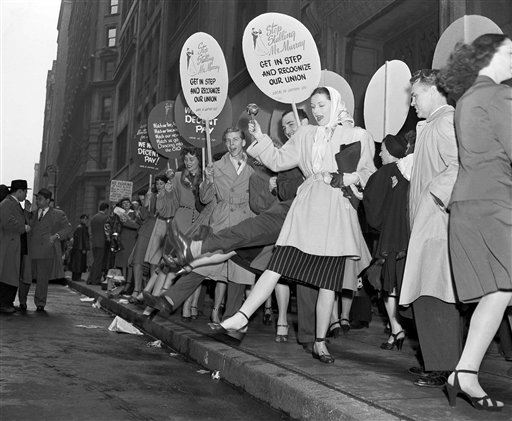In Bakery and Pastry Drivers and Helpers Local v. Wohl, 315 U.S. 769 (1942), the Supreme Court struck down an injunction against picketers who were protesting peddlers buying from bakeries and selling to small retailers seven days a week in conflict with union policies. In so ruling, the Court applied freedom of speech to New York via the 14th Amendment.
Court said picketing did not require a “labor dispute” to be lawful
New York state courts had ruled that the peaceful picketing had been unlawful because it did not involve a labor dispute as defined by state law. By contrast, in delivering the opinion of the U.S. Supreme Court, Justice Robert H. Jackson wrote: “One need not be in a ‘labor dispute’ as defined by state law to have a right under the Fourteenth Amendment to express a grievance in a labor matter by publication unattended by violence, coercion, or conduct otherwise unlawful or oppressive.”
In so writing, Jackson thereby clarified that the Court had denied certiorari to Opera on Tour v. Weber (1941), a similar case, because it was one in which “the question of the existence of a right to free speech under the Fourteenth Amendment was neither raised nor considered.”
Douglas thought the clear and present danger test should be aplied to picketing
Justice William O. Douglas authored a concurring opinion, joined by Justices Hugo L. Black and Francis W. Murphy, in which he observed, “If the opinion in this case means that a State can prohibit picketing when it is effective but may not prohibit it when it is ineffective, then I think we have made a basic departure from Thornhill v. Alabama, 310 U.S. 88 [1940].”
Douglas sought to apply the clear and present danger test to picketing cases and thought that any restrictions on peaceful picketing would have to be drawn more narrowly than the statute under which the injunction had been justified.
Douglas acknowledged that “picketing by an organized group is more than free speech” and can be a proper “subject of restrictive regulation,” but he further noted that because the “ ‘dissemination of information concerning the facts of a labor dispute’ is constitutionally protected, a State is not free to define ‘labor dispute’ so narrowly as to accomplish indirectly what it may not accomplish directly.”
John Vile is a professor of political science and dean of the Honors College at Middle Tennessee State University. He is co-editor of the Encyclopedia of the First Amendment. This article was originally published in 2009.

